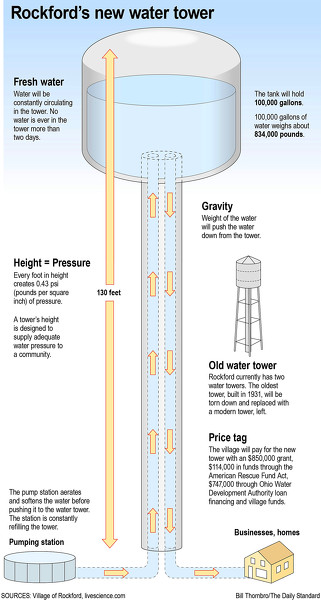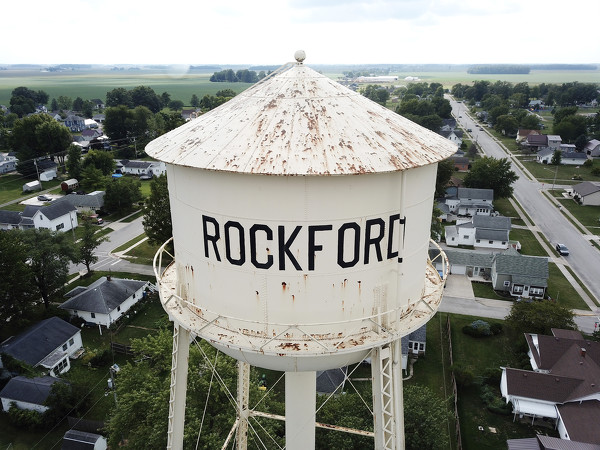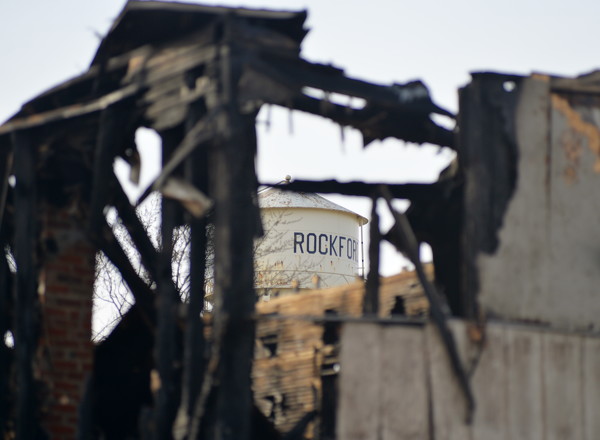ROCKFORD - Earlier this month, a fire reduced two historic buildings to ash on North Main Street in Rockford.
Dozens of firefighters from 12 departments in two counties on March 1 battled the blaze for 10 hours and at one point exhausted the town's water supply and had to draw water from the St. Marys River and a nearby creek.
No one was injured in the fire that demolished DJ's Auto Repair and Wildfire Bar and Grill on North Main Street. The fire remains under investigation.

Rockford's new water tower.
In light of the fire and the resulting exhaustion of the water tower's supply, The Daily Standard decided to take a look at how water towers work, what their purpose is and how they're made.
Although water towers are simple in nature, the mechanics of storing and distributing water can be extensive and complex.
The general process is straightforward - clean, treated water is stored in a large tank where it's dispersed throughout the community.
Rockford currently has two water towers which provide the village with potable drinking water. The existing north water tower was built in 1931 between Columbia and Front streets, while the south tower was installed in 2000 near Hickory Street.

Rockford's old tower will be demolished.

The newer tower is getting refurbished.
Groundwater is stored in wells and sent to the village water plant for treatment via underground pipes, according to village administrator Aaron Temple. It is then pumped into the water towers.
"As the (water treatment) plant pumps the water in through the lines and through the system underground, there's a main feed that runs into each tower," he said. "From there, there's a center line that runs up the middle of the towers and it fills the tower."
The north water tower holds 100,000 gallons and the south holds 250,000 for a combined 350,000 gallons. Temple said the village uses 200,000 gallons a day on average.
"Some time throughout the day, 200,000 gallons has to come out of that 350,000 and be replenished. It's not up in there more than two days," he said.
The amount of time required to replenish water inside the towers depends on how much water the village usses. If the village uses 250,000 gallons in a day, for example, Temple said it usually takes a few days for the tower to refill. If the village uses only 150,000 gallons, the supply could refill in one to two days.
"It just depends on what's being taken from the system at the same time that we're trying to replenish it," he said.
An epoxy coating on the inside of the massive water tanks prevents rust and corrosion, Temple said. Freezing inside the tower also isn't a concern because the water is in constant motion, he added.
The village is in the middle of a water tower rehabilitation and reconstruction project. The project involves demolishing and rebuilding the north water tower and rehabilitating the south tower, which will both hold the same amount of water.
The north tower has legs while the south tower has a center beam. The new north tower will also have a center beam, according to village fiscal officer Lisa Kuhn.
The difference between the two is cost-related. Temple said it is more cost-effective for maintenance to build a pedesphere-style tower, which has a center mass instead of separate legs.
Rockford officials have been discussing the water tower rehabilitation and reconstruction project for months.
Earlier this year, councilors passed a resolution awarding Iseler Demolition of Kinde, Michigan, a $35,400 contract to demolish the north water tower and awarding L.C. United Painting Co., Inc of Sterling Heights, Michigan, a $438,500 contract to rehabilitate the south water tower. A new north tower will be built once the existing north tower is demolished, Temple had said.
In September, councilors awarded a $1.25 million contract to Caldwell Tanks of Louisville, Kentucky, to build the new tower, which is expected to be completed in October, Temple had said.
The village will pay for the water tower with an $850,000 grant, $114,000 in American Rescue Plan Act funds and $747,500 through Ohio Water Development Authority loan financing, Temple had said. The rest of the cost will be paid with village funds.

The old Rockford water tower can be seen through rubble from the March 1 fire in Rockford.